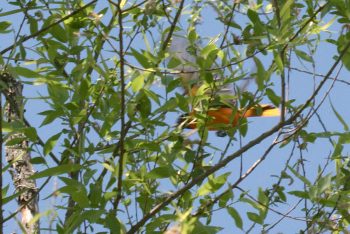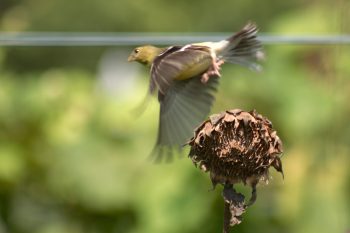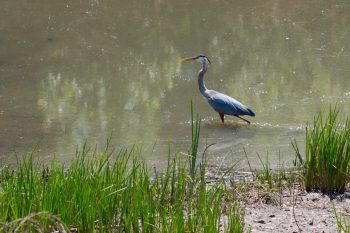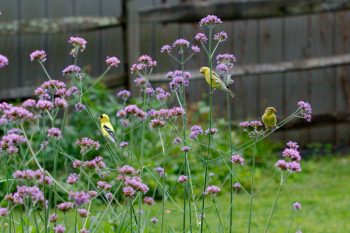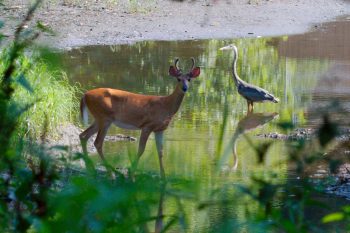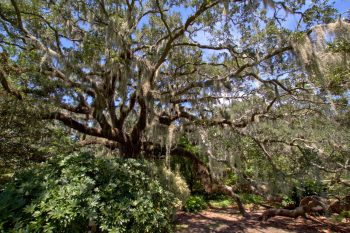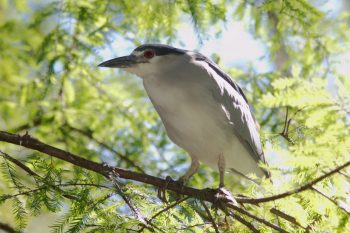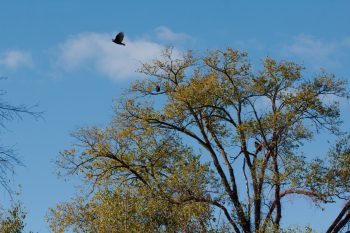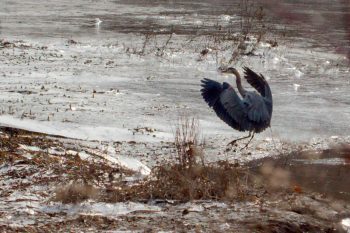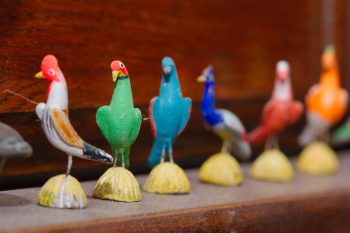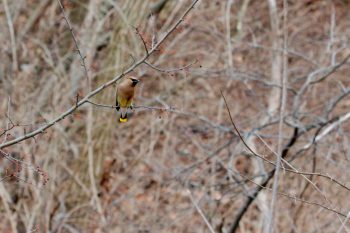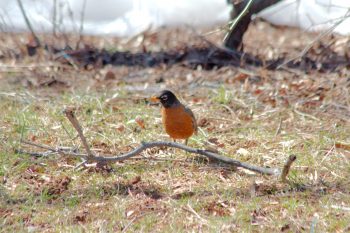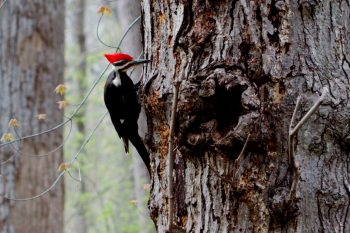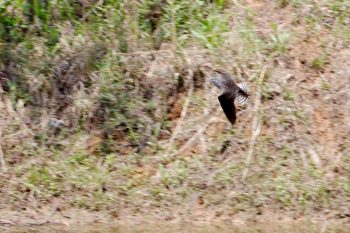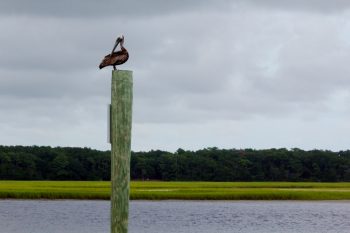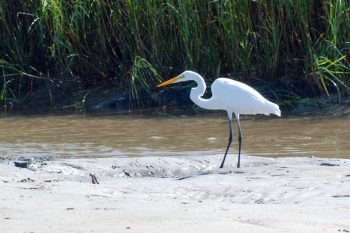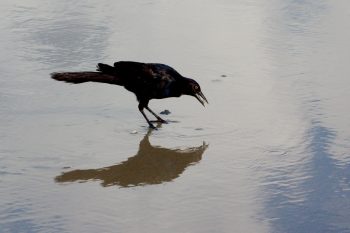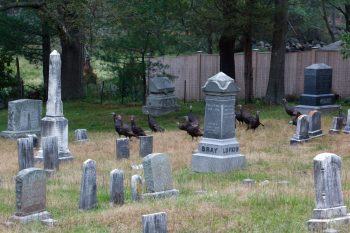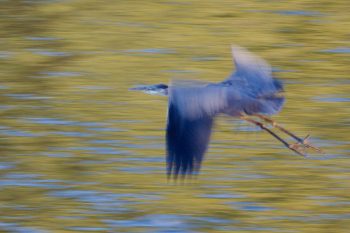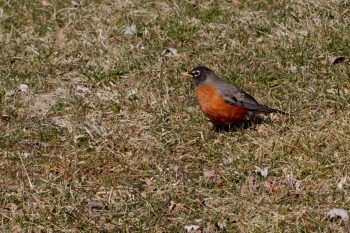As an illustrative photo this isn’t much but seeing an oriole (Icterus galbula) is rare enough that any photo that catches the color is pretty cool, in my book. I got two others of it on a branch but it’s mostly hidden by the branch. I could hear it singing after it flew to a different tree so I have hopes of seeing it again.
Tagged With: Birds
Baltimore Oriole
American Goldfinch
The horizontal wire just above the bird bothers me a bit but otherwise I really like this picture. It is a female American goldfinch (Carduelis tristis) taking off from a dried sunflower growing between rows of grape vines (which is what the wire is for) at Rocklands Farm.
Great Blue Heron (Ardea herodias)
I went out into the woods next to my building late this morning. There wasn’t a lot that I found interesting but I took a few pictures. Before I went back inside, though, I thought I’d walk over to the pond on the other side of the building and see if the ducklings were still there. They were not but this great blue heron (Ardea herodias) was and I was able to get a few decent pictures before he flew off. I also watched a couple tiger swallowtails (Papilio glaucus) fluttering around and getting water from the mud at the pond’s edge. All in all, a nice, relaxing outing to break up an otherwise uneventful day at the office.
American Goldfinches (Spinus tristis)
We have a fair amount of Verbena bonariensis growing around the yard. It’s somewhat of a weed but for the most part, we let it go, just keeping it barely within bounds. There are a few reasons for us letting it go. First, of course, is that it’s pretty on its own. I mean, the purple adds a bit of contrast to all the green in the early summer and it’s generally still in bloom when the black-eyed Susans really start to go crazy. But I think the main reason is that the American Goldfinches (Spinus tristis) really seem to like it. Usually I’ve been unable to get close enough to get even a poor photo of them before they fly away but this afternoon I got a reasonable picture showing three finches. They are such lovely birds and we enjoy watching them bounce around on the tall stems of the Verbina.
Deer and Heron
I went out to the woods next to my building this afternoon, towards the end of the day. After wandering around there a while without finding much of interest, I went down towards the tiny pond on the other side of the building and came across this white-tailed deer (Odocoileus virginianus) and great blue heron (Ardea herodias) sharing the watering hole together. The picture isn’t great but I’m happy I was able to get a picture of both of them before the both decided I had ruined the party and they left.
Brookgreen Gardens and Lowcountry Zoo
A bunch of us went to Brookgreen Gardens today. Seth, Iris, and Tsai-Hong stayed until about 1:00 before moving on to the lowcountry zoon and then headed back to the beach. Cathy, Dorothy, Jonathan, Dot, and I had lunch and then did a bit more walking in the gardens before hitting the zoo. I took a lot of pictures of sculpture and a few of dragonflies and grasshoppers (the huge eastern lubber grasshopper, Romalea microptera). I really enjoy both the sculpture and the setting. It was hot today but not really hot by South Carolina in August standards. In the shade it was actually pretty pleasant. This first picture is of my favorite tree at Brookgreen gardens. It is in the corner of the Palmetto Garden and really is part of the Live Oak Allée that’s just across the wall. I think it’s magnificent.
Of course we also went to the lowcountry zoo where we saw black-crowned night-herons (Nycticorax nycticorax) as well as a few egrets and an ibis. The otters were very active and we enjoyed watching them swim around for a while. It was actually feeding time at the alligator pond but the alligator we saw must be well fed because he was pretty blasé about the whole thing.
After leaving Brookgreen, we drove to Murrill’s Inlet for an early dinner at Nance’s. Dorothy, Jonathan, and I shared a half bushel of steamed oysters while mom had soft-shell crab and Cathy had a crab cake.
Turkey Vultures (Cathartes aura)
I was outside for a little while today and took a few pictures. Most of them were of trees reflected in the windows on the outside of my office building. They are not as colorful as in some years but with the blue sky behind them and the slight distortions of the not-quite-flat glass, they made for interesting pictures. Then I noticed a vulture land in this tree. I took two pictures of the tree in reflection and then turned around to get a couple directly. There are three birds in the tree and just after I snapped one picture, a fourth turkey vulture flew through the frame and I grabbed one more shot. Actually, I’m not sure they are all turkey vultures. At least one may be a black vulture (Coragyps atratus).
Great Blue Heron (Ardea herodias)
After a meeting across campus today, I stopped to take some pictures of the ice around the drainage control pond next to my building. With the rain on Thursday and Friday, the water had been high. As it drained, the temperature dropped and it froze, but the water level continued to drop, leaving lots of ice around the banks of the pond. As I walked down through the middy area leading to the pond, this great blue heron (Ardea herodias), took off and flew a little further away from me. After that, he waded around and I was able to get a few more pictures, both from this side (where he is back lit) and from the other, with the sun shining on him from over my shoulders. Without more than a 100mm lens, this is the best I could do.
Little Bird Statues
Cathy has a roll-top desk that we got from some friends who where ready to get rid of it. Along the top of the roll-top, which is never closed, there is a little ledge where the top doesn’t go all the way into the carcass. She has a few little things sitting on that ledge including a line of dice of various sizes and side-counts. In the middle is this line of little bird statues. I don’t rightly know where she got them (I suppose I could have asked) but there they are. They are quite colorful—as you can see—and they stand about an inch tall. This green on is one of my favorites, along with the dark blue peacock colored bird in the center of the photo.
White-throated Sparrow (Zonotrichia albicollis)
I had a dentist appointment this morning and that meant that I got to work a little later than normal. It was cool out but sunny and bright. As I Parked the car at work I saw a red-bellied woodpecker (Melanerpes carolinus) fly past and land on a tree across the parking lot. I got my camera out and walked towards it. I got one picture from a fairly large distance but for the most part it kept to the far side of the tree it was on and eventually it flew away. I spotted this white-throated sparrow (Zonotrichia albicollis) and managed to get quite a bit closer. It’s a cheerful little bird, and quite pretty with its yellow patch (and of course its white throat).
Cedar Waxwing (Bombycilla cedrorum)
It rained overnight but was mostly clear today and quite warm for mid-February. After a meeting that ran from 11:30 to just before noon, I walked a bit in the woods and upland area next to my office. First, I walked down into the woods above the drainage pond where a fair sized flock of cedar waxwings (Bombycilla cedrorum) were bouncing around in the underbrush. If I had a tripod and a longer lens I think I could get some pretty good photos in that area. As it is, this is good enough for identification purposes but it isn’t going to win any awards. Still, it was nice to be out with the birds in 60°F weather in the middle of winter.
American Robin (Turdus migratorius)
With a specific name like Turdus migratorius, you might thing the American robin is only here part of the year. After all, migratorius implies it migrates. Well, it does. Nevertheless, for the overwhelming part of the 48 contiguous states, the robin is a year-round fixture. Their summer breeding grounds extend from the southern states (and include the mountains of central Mexico) to cover all but the most arctic portions of Canada. In the winter they move south, with their northern limit right around the U.S.-Canadian border. So, if you live in Canada, their arrival is a sure sign of spring. The birds we see in the summer may not be the birds we see in the winter but frankly, they all look pretty much alike. We often see them eating berries on the holly in our front yard. This time of year, as it begins to warm up, they are active pulling up worms, as this one was doing before being so rudely interrupted by me.
Dryocopus pileatus (Pileated Woodpecker)
It was a beautiful day and Cathy and decided to take a short walk in nearby Rock Creek Park. With her ankle problems we didn’t want to overdo it, so this seemed like a good way to get out, at least a little. Before we had even gotten as far as the bike trail that runs along the creek we spotted this piliated woodpecker (Dryocopus pileatus), who landed on a tree not too far from us. We also saw a few white-tail deer (Odocoileus virginianus) (White-tailed Deer), including one that was seriously not bothered by our presence. We saw a small flock of cedar waxwings (Bombycilla cedrorum). There was also a nice assortment of wildflowers including star chickweed (Stellaria pubera), a pretty, little, white, star-shaped flower.
Solitary Sandpiper (Tringa solitaria)
I took a little walk at lunch time today, around my building and then into the woods. There is a tree that fell across the stream a year and a half ago and I’m still able to get across on that. One of these days it’s going to collapse under me, but so far, it’s been alright. There are a few drainage ponds on the upper part of the property and they have water in them now, even though our April was dryer than normal. I saw a bird across the pond and as if flew off I was able to get two pictures of it. Judging by its size and shape and with only a very brief glance at it, I had thought it was a killdeer (Charadrius vociferus). Once I saw the picture, though, I knew that was wrong. After a little searching, I decided it was a solitary sandpiper (Tringa solitaria), migrating to its summer breeding grounds in the far north (entirely north of the USA/Canada border). As usual when it comes to identifying birds, I checked with George to see if he thought I was right. He did.
Brown Pelican (Pelecanus occidentalis)
We had a bit of rain this morning but it cleared up later and we went swimming. Late in the day I went for a little drive to find somewhere to take pictures. On the mainland near the east end of the island is a boat ramp. There used to be a ferry across to the island there and it’s a pretty place. I took some pictures of marsh grass growing on the banks of the channel and also got a nice photo of a tiger swallowtail (Papilio glaucus). From there I drove to the Shallotte River inlet and took some pictures of this brown pelican (Pelecanus occidentalis) perched on a pole out in the water.
Great Egret (Ardea alba)
Cathy, Dorothy, and I went for a drive this afternoon, going to a pond near Sunset Beach where we’ve seen alligators (Alligator mississippiensis). There was one close to the shore and I got a few pictures of it along with some water turtles. Then we drove back onto the island and to the east end, where I got some nice pictures of this great egret (Ardea alba) wading in the tidal marsh and finding fish in the shallows. We also walked on the beach at that end of the island and enjoyed the wind and the deeply colored, wine dark sea.
Grackle Eating a Clam
We went swimming early this afternoon and then I dug in the sand and made a drip castle. After showering, Cathy and I walked on the beach. I was surprised that the castle was still there. The tide hadn’t come in yet but no one had stepped on it. On our walk we saw a few common grackles (Quiscalus quiscula) just above the surf pulling up clams after each wave. It’s not really surprising that they’ve learned to enjoy clams. It’s just that we don’t think of grackles as shore birds, skipping around at the top of the surf along with willets and sand pipers.
Turkeys in a Cemetery
As we left our AirBnB this morning, heading for home, we passed this little cemetery and saw a flock of wild turkeys (Meleagris gallopavo) among the grave markers. We stopped and took some time to walk around the cemetery a little and enjoy the quiet, as well as the birds. As I walked across the top of the cemetery, they moved slowly towards and then through an opening in the fence behind them. We used to see turkeys a lot more often than we do now. In Pennsylvania we would see them somewhat regularly and also ring-necked pheasants (Phasianus colchicus, the common pheasant of Asia, introduced into North America in the late 18th century). We almost never see them any more, so this was a treat for us.
Great Blue Heron
I decided to take a bit of a detour on the way home, stopping at Upper Rock Creek Park along the east bank of Lake Needwood. I find it very frustrating that the powers that be they have put up barricades on Needwood Road that make it impossible to park there and enjoy that end of the lake. I don’t really understand that decision. It’s obviously something that was thought out and specifically decided, as some of the guard rails are not protecting anything except places that one might otherwise park their car. Anyway, I drove through the park and ended up parking at the south end of the lake. As I was walking I startled a Great Blue Heron (Ardea herodias) and was just able to get one somewhat blurry photo before it flew out of range.
American Robin (Turdus migratorius)
I took a few pictures as I walked across campus to a meeting early this afternoon and then a few more on the way back. On the way over I saw a flock of native sparrows bopping around in the underbrush and took a few pictures but really they were too far away to get anything worth posting. I also took some pictures of the ripples on the stream that flows through the property. On the way back I looked for the sparrows but they seem to have moved on. There were, however, a few American robins (Turdus migratorius) pulling worms out of the grass. Although they are migratory, we have them year round here, with those that migrate from New England and Canada only making it this far south for the winter.

